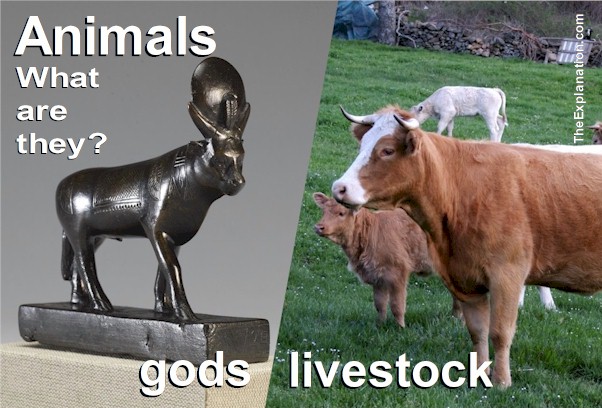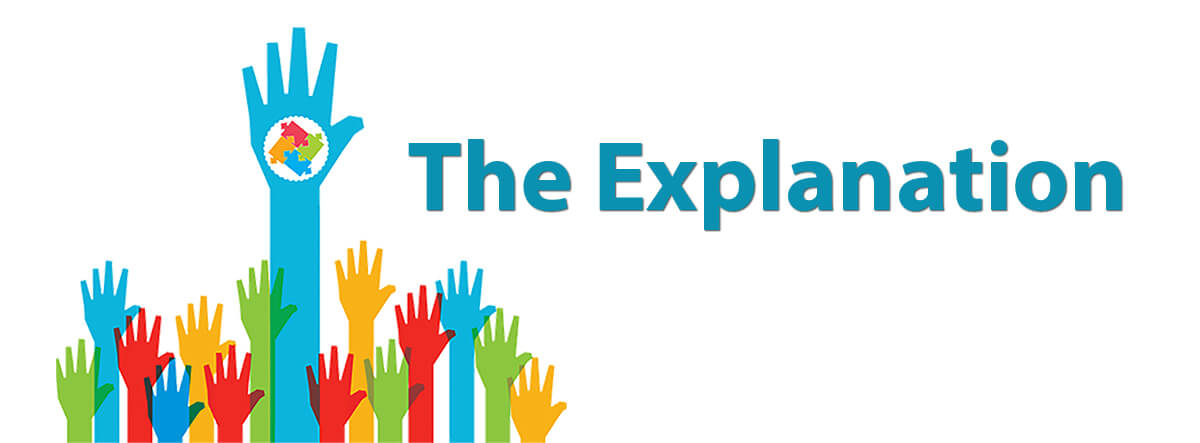Contents
The state of fauna: Revered on one side, raised as livestock on the other. How do humans respect animals?

Animals as gods and livestock. What is their role on planet Earth, and how should humans treat them?
Another wave of Galacti’s hand and we find ourselves standing in an animal park. Plants still surround us: as we’ve seen, they’re necessary for any animals to survive! But it’s the creatures great and small that command our attention—birds, beasts, fish in ponds, whales in enormous pools. I am struck by the variety and majesty of all the Earth’s creatures.
(Audit of the Universe, chapter 6.1)
“When we last looked at the fauna of the earth,” Galacti tells us, “we said they each had skills and roles that helped them survive in the competitive, often brutal, world of fauna. We identified communicators like bees and dolphins, organizers like ants, navigators like the carrier pigeon, climbers like monkeys, swimmers like beavers, tool-makers like otters and home-builders like badgers. Within their areas of specialization, animals have physical abilities and instinctual skills that make them the world-leading best at what they do.”
I remember thinking back to Chapter Six of Inventory of the Universe and the amazing capabilities of the animals with which we share the Earth.
“But man has divided them into other categories, according to your relationship with each. Like their niches in the world, this categorization has powerfully affected how well an animal lives, and how likely a species is to survive into the next century.”
“I hadn’t thought of it that way,” I admit. But he’s right.
Animals as Elders
Early religions often held many animals equal to or higher than humans. We would imagine they had human souls and developed animistic and totemistic beliefs around respecting or warring with those souls (depending on the individual culture). Some of our ancient societies elevated animals and livestock to the status of gods. The ancient Egyptians worshiped cats and crocodiles, while Native Americans revered the spirits of the Bear, Raven, and others. Even in cultures that did not place as much importance on the animals and livestock around us, we lived in balance with the fauna of the Earth. Humans had not yet developed the technology or numbers to do anything else.
As man modernized, that balance changed. Humans have become the dominant life form on the planet, and our decisions affect the lives of every creature with which we share it. Those effects rely on our relationship with each kind of animal:
- Those we consider possessions, for which we feel a sort of paternal responsibility or mutually beneficial symbiosis
- Nuisances and threats, which we work tirelessly to reduce or eradicate
- Those who we rarely notice at all. These animals may have the saddest fate of all.
In this part of our Audit of the Universe, we join Galacti in an in-depth look at a lot of animals in each of these relationships. We examine how humans have changed their lot for good or ill.
Possessions
For better or worse, we are the most powerful form of life on Earth.
“Better for man, certainly. How has it worked out for the animals around him?” Galacti suggests.
“Wait for it,” I say. “We’ll see.”
Because of this position, we have, for thousands of years, considered some kinds of animals and livestock as belonging to us. Depending on the animal in question, this has worked out better or worse for them.
Livestock
Traditionally, we lived with livestock in a balanced symbiosis. Family farmers and ranchers raised their animals carefully, fed them appropriately, and slaughtered them for food at a pace that kept up with reproduction. We understood that killing our food animals faster than that would mean less food in the years to come. This relationship allowed the animals as a species to survive more easily than in the wild—though the final fate of any individual animal could be considered grim. The arrangement also helped us, since we got nutrition from each animal without having to expend calories or risk injuries on the hunt.
Modern industrial farming stands in sharp and ugly contrast. Animals are born and die in small pens, often lacking room even to turn around. They get packed together by the thousands in spaces that breed disease and house hosts of parasites. Health can be neglected since the acceptable losses of a few hundred individuals per growing season costs less than health care for thousands.
Most industrial raised livestock are injected with massive doses of antibiotics, and some nations still permit hormone treatments to make the animals grow faster and fatter. Though research is still ongoing as of 2017, there are strong indications that residue from both remains in the meat and harms the health of those who eat it. What is more certain is that such treatment degrades the quality of life for all animals born, grown, and slaughtered within the industrial livestock system.
As with most situations where we are involved, industrial farming demonstrates our dual nature. On one side, you see inhumane and potentially harmful methods adopted because they foster easy profits. On the other, you have individuals like Dr. Temple Grandin.
Dr. Grandin is a researcher in human and animal behavior and has designed several stockyards, corrals, races, chutes, and loading ramps specifically built to give food animals better life conditions and a more humane slaughter. For example, she designed a curved cattle chute that takes advantage of the natural movement of cows. Cattle moving through this chute experience less distress and require less prodding from handlers while moving through the chute. She teaches at Colorado State University in Fort Collins, Colorado, to lead research in sustainable, humane relationships between livestock and we humans who need them.
She is but one example of a general movement toward a more balanced relationship with our food animals. A variety of grassroots movements throughout the industrial world have opted for the humane treatment of livestock. Farmers and ranchers choose to keep their animals in cage-free conditions and let them roam large fields and pastures while eating natural healthy foods.
Are animals supposed to be injected with antibiotics and hormones and be huddled together in confined areas? Or live in cage-free conditions eating natural healthy food? What is our human responsibility in this field? Share on XAnimals in such conditions are less subject to disease and parasites, meaning the massive injections of antibiotics aren’t necessary. In support of this more humane approach, consumers – both private customers and restaurant supply buyers – voluntarily spend between 20 and 150% more on meat from these sources.
This blog post is an excerpt from chapter 6.1 of Audit of the Universe.
Dig Deeper into The Explanation
Online Study Courses to Uncover the Mystery of Adam and Eve’s Nakedness… with no fuss. Free video mini-course revealing the God-intended meaning of Scripture via Biblical Hebrew. It’s so easy, it’ll blow you away. Join now and add new motivation to your Bible study.
Join The Explanation Newsletter to stay informed of updates. and future events. No obligations, total privacy, unsubscribe anytime, if you want.
The Explanation series of seven books. Free to read online or purchase these valuable commentaries on Genesis 1-3 from your favorite book outlet. E-book and paperback formats are available. Use this link to see the details of each book and buy from your favorite store.

Since you read all the way to here… you liked it. Please use the Social Network links just below to share this information from The Explanation, Livestock and Fauna as gods. Humans both Revere and Eat Animals



Trackbacks/Pingbacks